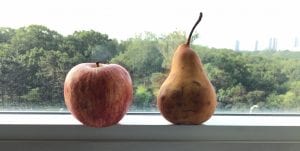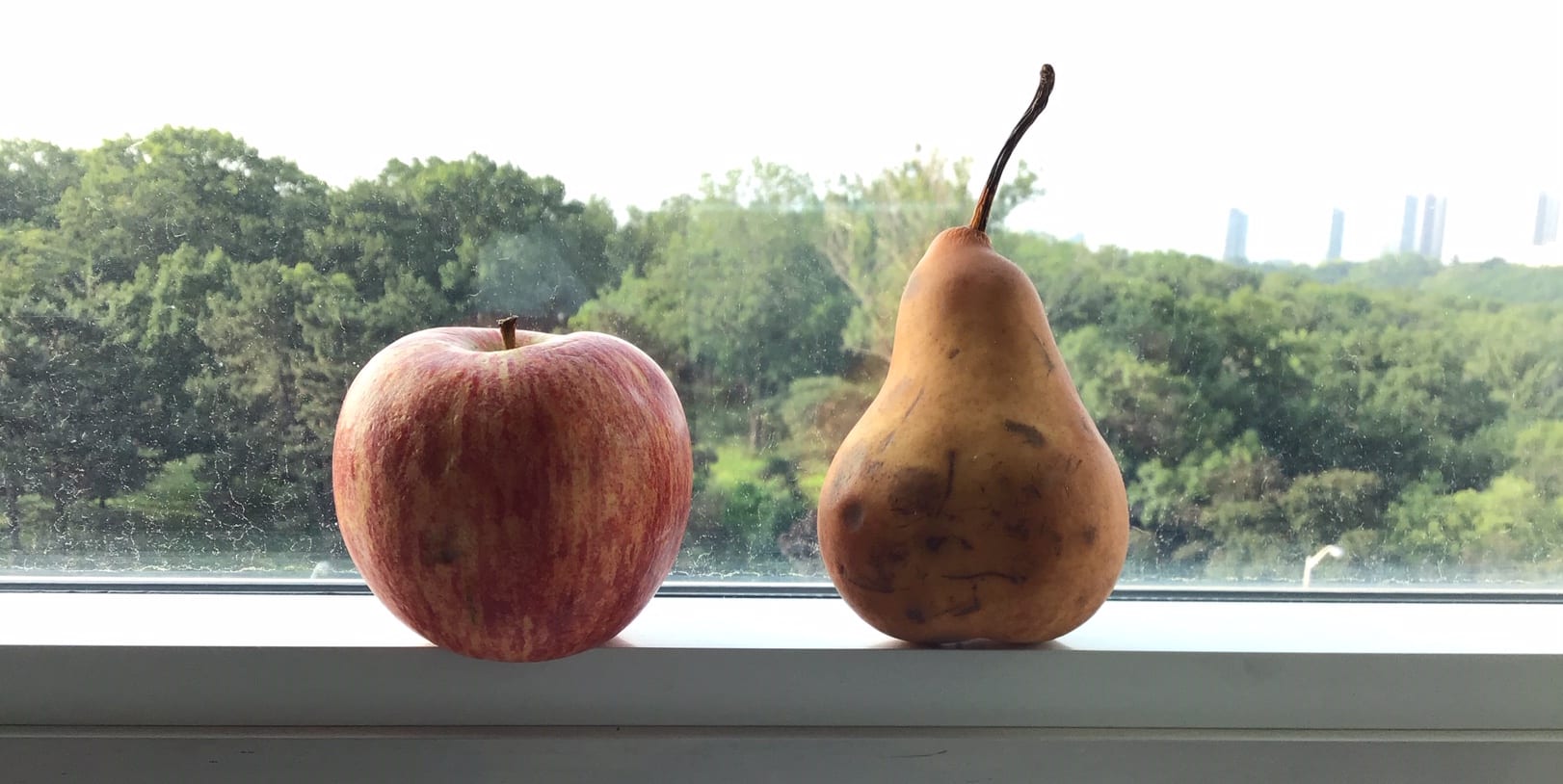Are you apple-shaped or pear-shaped?
Women come in all shapes and sizes. A new study found that postmenopausal women with normal weight have a higher risk of cardiac disease if they are apple-shaped rather than pear-shaped.
During the menopause transition when estrogen levels fluctuate and decline, weight gain is common and changes in body shape occur – fat tends to migrate to the middle of the body and deposit around the waist.
BMI or Body Mass Index is a tool that checks your weight against your height and is used by healthcare practitioners to determine if a woman is underweight, normal weight, overweight, or obese.
BMI
Underweight Below 18.5
Normal 18.5–24.9
Overweight 25.0–29.9
Obesity 30.0 and Above
It is known that the higher the BMI the higher the risk for certain diseases such as heart disease, high blood pressure, type-2 diabetes, gallstones, breathing problems, and certain cancers.
The total body fat in women with normal BMI isn’t associated with a higher risk of cardiovascular disease (CVD) but where these normal-weight women store their fat may determine their risk of heart attacks and strokes.
Results from research led by Dr. Qibin Qi, an associate professor at the Albert Einstein College of Medicine, New York (USA), on US postmenopausal women (predominantly white) found that higher belly fat (apple-shaped) was associated with increased risk of cardiovascular disease while higher leg fat (pear-shaped) had a lower risk of CVD. Women with high belly fat and high leg fat had a three-times increase of CVD.

Are you apple-shaped or pear-shaped?
Why is accumulation of fat around the belly (apple-shaped rather than pear-shaped) detrimental for heart health of postmenopausal women?
Because fat stored around the belly is not only skin deep, it is also inside the body covering the organs. Fat stored around the organs in the abdomen increases risk of certain diseases such as diabetes, higher cholesterol levels, inflammation, and heart disease. The reason why fat accumulated around the legs may protect women from disease isn’t completely understood but it may be because it doesn’t cause problems in other parts of the body.
Science shows that being overweight and obese is detrimental to your overall health, but so is being apple-shaped without being overweight. Where does that leave you if your body weight, BMI, and body-shape put you at increased risk for disease?
Dr. Qui said “While there have been some large studies of genetic determinants of upper- and lower-body fat, fewer large studies have focused on lifestyles factors, though modifiable factors such as physical activity and dietary intakes are thought to play key roles in determining an individual’s fat distribution”.
That means that the food you eat and the amount and type of physical activity you do play an important role in how much and where you accumulate fat.
You can’t change your genes but what you eat and what you do in terms of physical activity are yours to choose. Some choices are easier than others. But if you are apple-shaped and not doing anything it may cost you your life. So why not try something?
I know it isn’t easy. I work at it every day. Due to family history I have a higher risk of diabetes and my hips are narrow, making me a good candidate for being apple-shaped if I don’t watch what I eat and what I do.
The most helpful thing, I believe, is to make good choices a habit in your life. Because once you’re doing something by habit you aren’t struggling to do it. Do you huff and puff and complain every time you brush your teeth? No, it’s been a long habit.
Until good nutrition and proper exercise become part of your daily or weekly routine—until they become a habit—it will be hard to keep at it. But if you stick with it for 3 months, at least, the more likely you are to succeed.
Here are some tips for good nutrition and physical activity:
Eat wisely:
- Eat several servings of fruits and vegetables daily, especially dark greens and colourful fruits and vegetables
- Stop buying food in boxes. Processed foods are higher in fats and other less-healthy ingredients
- Reduce portions. Most people eat more food (calories) than needed and recommended for good health. Remember that to lose weight you need to eat fewer calories than you spend. So, if you aren’t engaging in physical activity then most of what you eat will be stored as fat.
- Drink water. Before you reach for that glass of wine, think about the calories and the increased risk of breast cancer
- Cook from scratch. I make many of the recipes on lentils.org
- Make a menu plan for the week with an accompanying shopping list and buy the groceries you need (no junk) once a week. This helps to save money and calories, and it decreases food waste.
- Eat mindfully. Look at the food on your plate, smell it, appreciate the flavours in your food, and eat s-l-o-w-l-y. If possible with good company. I believe a meal is an occasion, not just fuel.
Be physically active:
- Women 40+ should engage in 120 minutes of exercise per week
- Exercising doesn’t have to mean that you need a membership fee and must hit the gym daily but remember that there are three types of exercise women should do – cardio, weight bearing or strength exercise, and balance. Ok, four, since stretching is also very important! But to get rid of the fat in the middle, exercises targeting the mid-section, improving core strength, may offer the best results (running, for example, isn’t likely to strengthen your core). Not sure what type of exercises to do? Hire a trainer. Don’t have money for a trainer? I hear you. I needed to get rid of my muffin top so I invested my money in my health, I hired a trainer twice a week and stopped buying clothes and shoes. We have choices, remember? Choosing your health first should be your priority. After a few months I reduced my workouts with my trainer to once a week. I can’t let him go because I know I don’t have the will power to go to the gym on my own twice a week. If money is an issue, hire a trainer for 3 months if you can’t afford it longer and learn how to exercise properly (posture, repetitions, etc.), and afterwards go to the gym and do the exercises on your own.
- Mix things up. It’s boring and not ideal for your body to do the same exercises over and over again. Combine all three types of exercises (cardio, strength and balance) weekly and do some exercise EVERY DAY. If you are into gadgets there are plenty of models and types to help you track your activity.
Be kind to yourself:
- Don’t hit yourself over the head with guilt and abuse if you didn’t eat the recommend servings of vegetables, or had more ice cream or pasta than you should and then didn’t burn them off by exercising. Remember, don’t tell yourself what you wouldn’t tell your best friend. Respect and compassion for your own person are important to succeed (not being perfect) at everything.
- Do better next day and keep trying your best …but don’t find excuses to get you off the hard work. Very little is accomplished without hard work. Your health isn’t the exception! It took me eight months of faithful exercising and watching what I ate (less carbohydrates-meaning goodbye to my beloved six slices of bread a day) to fit into a dress that didn’t make me look like an apple.
Don’t do it alone:
- Surround yourself with women who understand what you are going through, and better yet, women who are willing to support you and change their shape with you! Needing help isn’t a sign of weakness. As I always say: There’s help. I can help you!
- If you need me to encourage you one-on-one, support, or help starting out, call me. I offer 15-minute discovery calls free. Or book an appointment to change your life, and shape, in three months!
Teresa Isabel Dias is a pharmacist and Certified Menopause Practitioner (NCMP) who provides education and support on symptom management for women at work and at home so they’ll feel like themselves again and enjoy a vibrant and productive life.
Grab a quick guide and subscribe to the MenopausED Newsletter on the MenopausED home page.
If would like to know how Teresa can improve your menopause transition then schedule a complimentary Discovery Call at MenopausED.org.




